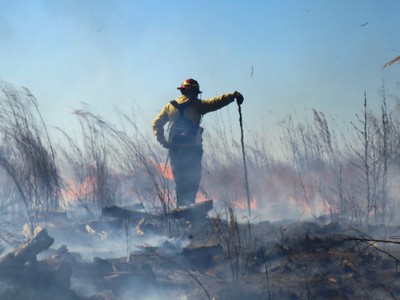Burning forests alter
watershed hydrological cycles by modifying soil and forest cover
properties. Researchers found that fires
with moderate or high burn severity contributed most to increased river flows,
but prescribed fires had little effect on water yield for large basins. Climate
variability such as drought may mask the effects of wildland fire on water
supplies, so effective forest management practices, such as prescribed burning,
must consider local watershed conditions.
 Today, there are more and larger forest fires compared to previous
decades, and their impacts are devastating. In addition to the immediate threat
to people and property, many fire effects only become evident with post-fire
rainfall that results in floods, mud flows, and sedimentation in dam lakes.
While these immediate impacts are obvious, risks to the continued availability
of water supplies are less visible. Though forests and rangelands provide more
than half of U.S. water supplies, the long-term impacts of fires, including
wildfire and prescribed fire, on water supplies have not been measured nor
factored into water management strategies. Researchers from the Eastern Forest
Environmental Threat Assessment Center and partners developed a coupled wildland
fire-water supply risk framework (known as FIWAS) to evaluate critical
environmental thresholds for water resources across the contiguous United
States. They discovered that wildland fires can enhance annual river flow in
western regions with a warm temperate or humid continental climate, in the
semi-arid Lower Colorado in particular. Most prescribed fires have a limited
extent and low severity impacts; therefore, climate trends have a much greater
impact on river flow where prescribed
fires burn in the Southeast. These outcomes, published in the journal Nature Communications, help researchers
evaluate the coupled wildland fire-water supply risk and contribute to
sustainable land management plans for safeguarding future water resources.
Today, there are more and larger forest fires compared to previous
decades, and their impacts are devastating. In addition to the immediate threat
to people and property, many fire effects only become evident with post-fire
rainfall that results in floods, mud flows, and sedimentation in dam lakes.
While these immediate impacts are obvious, risks to the continued availability
of water supplies are less visible. Though forests and rangelands provide more
than half of U.S. water supplies, the long-term impacts of fires, including
wildfire and prescribed fire, on water supplies have not been measured nor
factored into water management strategies. Researchers from the Eastern Forest
Environmental Threat Assessment Center and partners developed a coupled wildland
fire-water supply risk framework (known as FIWAS) to evaluate critical
environmental thresholds for water resources across the contiguous United
States. They discovered that wildland fires can enhance annual river flow in
western regions with a warm temperate or humid continental climate, in the
semi-arid Lower Colorado in particular. Most prescribed fires have a limited
extent and low severity impacts; therefore, climate trends have a much greater
impact on river flow where prescribed
fires burn in the Southeast. These outcomes, published in the journal Nature Communications, help researchers
evaluate the coupled wildland fire-water supply risk and contribute to
sustainable land management plans for safeguarding future water resources.
Pictured: A prescribed fire burns in a southern forest. Photo by Dennis Hallema, USDA Forest Service.
Related publications:
Forest Service Partners/Collaborators: Southern Research Station
External Partners/Collaborators: Oregon State University, Joint Fire Science Program
Contact: Ge Sun, Research Hydrologist, ge.sun@usda.gov
Next -->
<-- Previous




